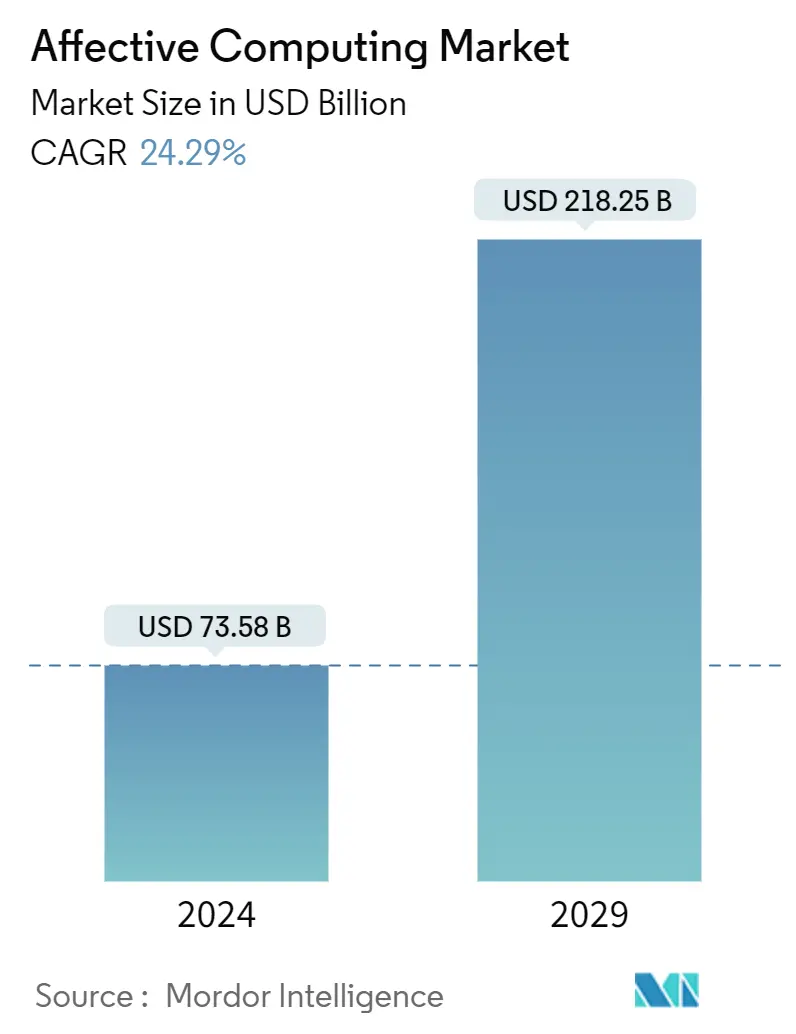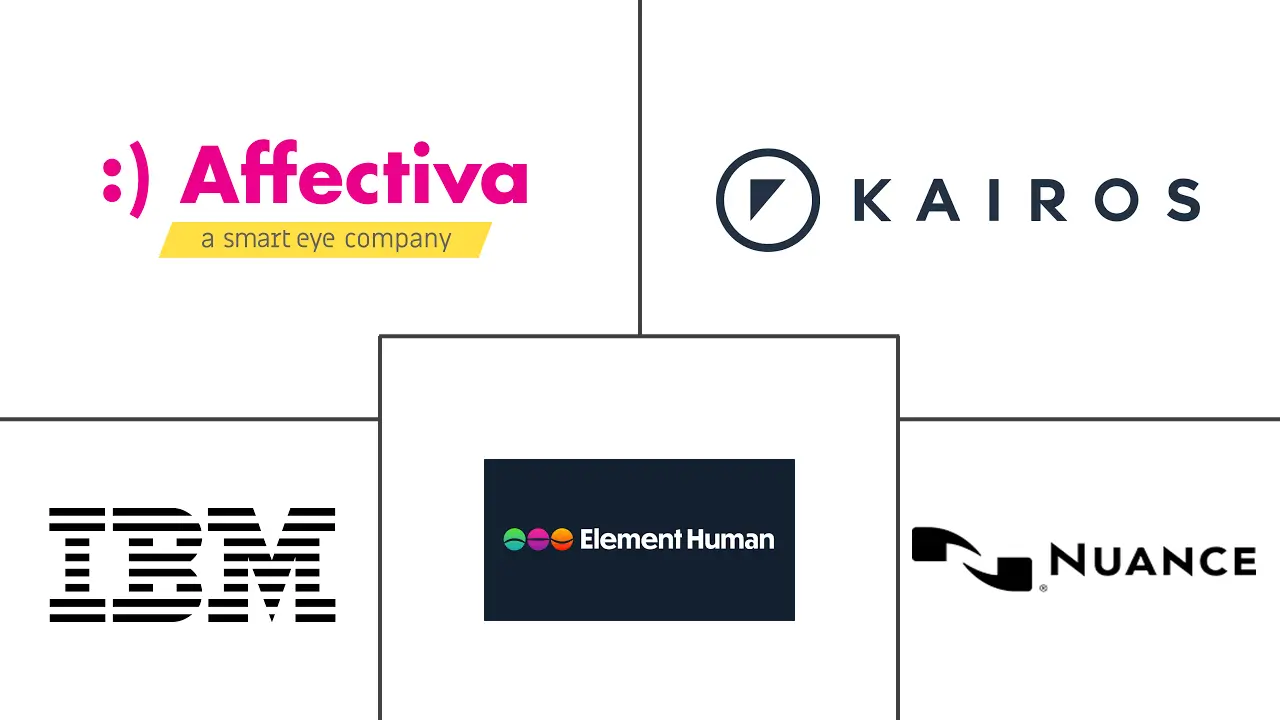Market Size of Affective Computing Industry

| Study Period | 2019 - 2029 |
| Market Size (2024) | USD 73.58 Billion |
| Market Size (2029) | USD 218.25 Billion |
| CAGR (2024 - 2029) | 24.29 % |
| Fastest Growing Market | Asia-Pacific |
| Largest Market | North America |
| Market Concentration | Low |
Major Players
*Disclaimer: Major Players sorted in no particular order |
Affective Computing Market Analysis
The Affective Computing Market size is estimated at USD 73.58 billion in 2024, and is expected to reach USD 218.25 billion by 2029, growing at a CAGR of 24.29% during the forecast period (2024-2029).
The rise in demand for telehealth-related affective computing solutions and the rising need for socially intelligent artificial agents are some significant factors that are anticipated to propel the growth of the affective computing market during the projected period. Furthermore, the demand for effective computing is expected to develop due to the increasing use of wearable technology, increased internet penetration across industrial verticals, and global technical breakthroughs.
- The affective computing market is developing due to the growing need for improved security in various industries and the demand for virtual assistants to detect fraudulent activities. Affective computing is used in multiple security applications, such as voice-activated biometrics, to restrict access to unapproved users. With the advancement in computing capacity, improved communication technology, and new solutions, such as AI, new possibilities are being realized, which will positively impact the market's growth.
- The emergence of affective computing has driven the growth of various applications. One of the significant areas in affective computing has been the design of computational devices that are proposed to showcase either natural emotional capabilities or capable of convincingly simulating emotions. For example, for speech impairments and emotionally handicapped people, Gestele, a prototype, was developed that adds to the affected people's emotions, gestures, or other forms of communication. The technology can also be used for personalization by adjusting light, type of music, and room temperature by detecting a person's mood, etc.
- Moreover, the increasing usage of robotics provides further incentives for implementing this technology. The recent advancement in robotics has led to an immense increase in the demand for artificially intelligent robots to behave politely and socially smartly. A report on World Robotics by the International Federation of Robotics (IFR) also showcased that worldwide industrial robot installations amounted to some 517,385 last year. It is prognosticated that by 2025, global industrial robot installations will amount to around 690,000. Additional feature inclusion, such as affective computing, can make these industrial robots much more acceptable and have better human-computer interaction.
- In its present technological capabilities, AI can support three essential business needs: automation of business processes, gaining insight through data analysis, and engaging with customers and employees. The third level requires cognitive engagement. Cognitive insights offered by machine learning differ from traditional analytics and require higher-level data. Due to such factors, these solutions are expected to improve further. Vendors are expected to form strategic partnerships with the end users to use the data for development purposes and offer them comprehensive solutions and services.
- Moreover, various organizations are engaged in innovations in applying affective computing (also called Emotional AI), which is expected to drive market growth during the forecast period. For instance, in August 2022, At the Massachusetts Institute of Technology (MIT), an innovative team used emotional AI to enhance people's mental well-being and general quality of life. Recent research from the MIT Media Lab's Affective Computing Research Group presents empirical proof that empathic artificial intelligence (AI) machine learning may mitigate the negative impacts of rage on human creative problem-solving.
- Affective computing market growth is anticipated to be hampered by issues with technical compatibility and high implementation costs, among other essential considerations. Implementing emotional computing requires a significant upfront investment, and delay in practical applications limits industry expansion. The system's expensive costs and difficulty comprehending user behavior further limit the market's development.
Affective Computing Industry Segmentation
Affective computing can be defined as the study of and creation of technologies for simulating, analyzing, and interpreting human emotions. The market for the study defines the revenues accrued from the sales of affective computing solutions across various end-users, including healthcare, automotive, retail, etc.
The affective computing market is segmented by component (hardware (sensors, cameras, storage devices, and processors), software (analytics software, enterprise software, facial recognition, gesture recognition, and speech recognition)), end-user industry (healthcare, automotive, and retail), and geography (North America, Europe, Asia-Pacific, and the rest of the world). The market sizes and forecasts are provided in terms of value (USD) for all the above segments.
| By Component | |||||||
| |||||||
|
| By End-user Industry | |
| Healthcare | |
| Automotive | |
| Retail | |
| Other End-user Industries |
| By Geography*** | |
| North America | |
| Europe | |
| Asia | |
| Latin America | |
| Middle East and Africa |
Affective Computing Market Size Summary
The affective computing market is poised for significant expansion, driven by the increasing demand for telehealth solutions and socially intelligent artificial agents. This growth is further fueled by the rising adoption of wearable technology, enhanced internet connectivity across various industries, and global technological advancements. Affective computing, which involves the development of systems capable of recognizing and simulating human emotions, is finding applications in diverse sectors, including security, where it is used in voice-activated biometrics to enhance safety. The integration of affective computing in robotics is also on the rise, as it enables robots to interact more naturally and socially, thereby improving human-computer interaction. The automotive industry is a major beneficiary, with affective computing being utilized in Advanced Driver-Assistance Systems (ADAS) to enhance driver safety and comfort.
North America, particularly the United States, stands out as a leading region in the affective computing market, supported by robust research initiatives and infrastructure for advanced technologies. The region is home to several pioneering organizations and companies, such as Affectiva Inc., which have made significant strides in the field. The competitive landscape is marked by aggressive acquisition strategies among key players like IBM Corporation and Nuance Communications Inc., aiming to capture market share and enhance their offerings. Despite the promising growth prospects, the market faces challenges such as high implementation costs and technical compatibility issues, which could hinder its expansion. Nonetheless, ongoing innovations and strategic partnerships are expected to drive the market forward, with affective computing technologies increasingly being integrated into various applications to improve user experiences and outcomes.
Affective Computing Market Size - Table of Contents
-
1. MARKET INSIGHTS
-
1.1 Market Overview
-
1.2 Industry Attractiveness - Porter's Five Forces Analysis
-
1.2.1 Bargaining Power of Suppliers
-
1.2.2 Bargaining Power of Consumers
-
1.2.3 Threat of New Entrants
-
1.2.4 Threat of Substitutes
-
1.2.5 Intensity of Competitive Rivalry
-
-
1.3 Assessment of the Impact of COVID-19 on the Market
-
-
2. MARKET SEGMENTATION
-
2.1 By Component
-
2.1.1 Hardware
-
2.1.1.1 Sensors
-
2.1.1.2 Cameras
-
2.1.1.3 Storage Devices and Processors
-
2.1.1.4 Other Components
-
-
2.1.2 Software
-
2.1.2.1 Analytics Software
-
2.1.2.2 Enterprise Software
-
2.1.2.3 Facial Recognition
-
2.1.2.4 Gesture Recognition
-
2.1.2.5 Speech Recognition
-
-
-
2.2 By End-user Industry
-
2.2.1 Healthcare
-
2.2.2 Automotive
-
2.2.3 Retail
-
2.2.4 Other End-user Industries
-
-
2.3 By Geography***
-
2.3.1 North America
-
2.3.2 Europe
-
2.3.3 Asia
-
2.3.4 Latin America
-
2.3.5 Middle East and Africa
-
-
Affective Computing Market Size FAQs
How big is the Affective Computing Market?
The Affective Computing Market size is expected to reach USD 73.58 billion in 2024 and grow at a CAGR of 24.29% to reach USD 218.25 billion by 2029.
What is the current Affective Computing Market size?
In 2024, the Affective Computing Market size is expected to reach USD 73.58 billion.

